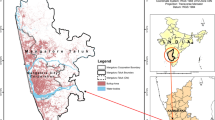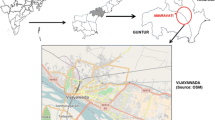Abstract
This paper focused on urban change detection and growth pattern analysis for the period of 1978–2017 at Kolkata using remote sensing data and GIS. The supervised Maximum Likelihood Classification technique is used to classify the multi-temporal satellite data in five classes which are urban built-up, open land, vegetation, agricultural land and water body. Results revealed that urban built-up area has progressively increased by about 21.17% (239.097 km2) during study period due to the new construction of roads, flyovers, settlements, etc. Other geographical features such as open land, vegetation, agricultural land and water body have gradually declined. To assess the accuracy of classification, 88.27%, 92.42%, 91.62%, 90.18% and 89.34% overall accuracy and 0.851, 0.904, 0.893, 0.875 and 0.866 Kappa statistic have been achieved for the images of 1978, 1988, 2000, 2010 and 2017, respectively. The degree of magnitude of urban sprawl has measured using the Shannon entropy method which demonstrates that the overall entropy values are progressively increased throughout the entire region that means the urban built-up is gradually extended in different positions. Moreover, entropy outcomes revealed that urban development occurred more in the northern and southern regions as compared with the other regions. From this study, four urban growth patterns have been found which are low density continuous, continuous linear, noncontiguous linear, and leapfrog development. The important patterns are continuous linear and noncontiguous linear because most of the urban development happened along the sides of the major roads or highways. Future prediction has been obtained using CA–Markov chain model and estimates that the urban built-up may be increased by about 56.18% (509.82 km2) in the year of 2031.












Similar content being viewed by others
References
Aal-shamkhi, A.D.S., Mojaddadi, H., Pradhan, B. and Abdullahi, S. (2017). Extraction and Modeling of Urban Sprawl Development in Karbala City Using VHR Satellite Imagery. In B. Pradhan (Ed.), Spatial Modeling and Assessment of Urban Form, Springer, Cham. pp. 281–296.
Ahmad, F., Goparaju, L., & Qayum, A. (2017). LULC analysis of urban spaces using Markov chain predictive model at Ranchi in India. Spatial Information Research, 25(3), 351–359.
Baker, W. L. (1989). A review of models of landscape change. Landscape Ecology, 2, 111–133.
Bhatta, B. (2009). Analysis of urban growth pattern using remote sensing and GIS: A case study of Kolkata India. International Journal of Remote Sensing, 30(18), 4733–4746.
Bhatta, B. (2010). Analysis of urban growth and sprawl from remote sensing data. Berlin: Springer Science & Business Media.
Bhatta, B., Saraswati, S., & Bandyopadhyay, D. (2010a). Urban sprawl measurement from remote sensing data. Applied geography, 30(4), 731–740.
Bhatta, B., Saraswati, S., & Bandyopadhyay, D. (2010b). Quantifying the degree-of-freedom, degree-of-sprawl, and degree-of-goodness of urban growth from remote sensing data. Applied Geography, 30(1), 96–111.
Dewan, A. M., & Yamaguchi, Y. (2009). Land use and land cover change in Greater Dhaka, Bangladesh: Using remote sensing to promote sustainable urbanization. Applied Geography, 29(3), 390–401.
Dewan, A.M. & Corner, R.J. (2014). Spatiotemporal analysis of urban growth, sprawl and structure. In B. Pradhan (Ed.), Dhaka Megacity, Springer, Dordrecht. pp. 99–121.
Donnay, J. P., Barnsley, M. J., & Longley, P. A. (Eds.). (2003). Remote sensing and urban analysis: GISDATA 9. Boca Raton: CRC Press.
Fichera, C. R., Modica, G., & Pollino, M. (2012). Land Cover classification and change-detection analysis using multi-temporal remote sensed imagery and landscape metrics. European Journal of Remote Sensing, 45(1), 1–18.
Halmy, A. W. H., Gessler, P. E., Hicke, J. A., & Salem, B. B. (2015). Land use/land cover change detection and prediction in the north-western coastal desert of Egypt using Markov–CA. Applied Geography, 63, 101–112.
Han, J. Y., Baik, J. J., & Lee, H. (2014). Urban impacts on precipitation. Asia-Pacific Journal of Atmospheric Sciences, 50(1), 17–30.
Hassan, M. M., & Nazem, M. N. I. (2016). Examination of land use/land cover changes, urban growth dynamics, and environmental sustainability in Chittagong city, Bangladesh. Environment, development and sustainability, 18(3), 697–716.
Hussain, M., Chen, D., Cheng, A., Wei, H., & Stanley, D. (2013). Change detection from remotely sensed images: From pixel-based to object-based approaches. ISPRS Journal of Photogrammetry and Remote Sensing, 80, 91–106.
Jog, S. & Dixit, M. (2016). Supervised classification of satellite images. In IEEE Conference on Advances in Signal Processing (CASP),pp. 93–98.
Karar, K., & Gupta, A. K. (2006). Seasonal variations and chemical characterization of ambient PM10 at residential and industrial sites of an urban region of Kolkata (Calcutta) India. Atmospheric research, 81(1), 36–53.
Lu, D., Mausel, P., Brondizio, E., & Moran, E. (2004). Change detection techniques. International journal of remote sensing, 25(12), 2365–2401.
Masek, J. G., Lindsay, F. E., & Goward, S. N. (2000). Dynamics of urban growth in the Washington DC metropolitan area, 1973–1996, from Landsat observations. International Journal of Remote Sensing, 21(18), 3473–3486.
Mather, P., & Tso, B. (2016). Classification methods for remotely sensed data. Boca Raton: CRC Press.
Meneses, B. M., Reis, E., Pereira, S., Vale, M. J., & Reis, R. (2017). Understanding driving forces and implications associated with the land use and land cover changes in Portugal. Sustainability, 9(3), 351.
Moghadam, H. S., & Helbich, M. (2013). Spatiotemporal urbanization processes in the megacity of Mumbai, India: A Markov chains-cellular automata urban growth model. Applied Geography, 40, 140–149.
Muller, M. R., & Middleton, J. (1994). A Markov model of land-use change dynamics in the Niagara Region, Ontario, Canada. Landscape Ecology, 9, 151–157.
Pandey, B., Joshi, P. K., & Seto, K. C. (2013). Monitoring urbanization dynamics in India using DMSP/OLS night time lights and SPOT-VGT data. International Journal of Applied Earth Observation and Geoinformation, 23, 49–61.
Petitjean, F., Inglada, J., & Gançarski, P. (2012). Satellite image time series analysis under time warping. IEEE transactions on geoscience and remote sensing, 50(8), 3081–3095.
Pouriyeh, A., Khorasani, N., Lotfi, F. H., & Farshchi, P. (2016). Efficiency evaluation of urban development in Yazd City, Central Iran using data envelopment analysis. Environmental monitoring and assessment, 188(11), 618.
Ramachandra, T. V., Aithal, B. H., & Sanna, D. D. (2012). Insights to urban dynamics through landscape spatial pattern analysis. International Journal of Applied Earth Observation and Geoinformation, 18, 329–343.
Sarvestani, M. S., Ibrahim, A. L., & Kanaroglou, P. (2011). Three decades of urban growth in the city of Shiraz, Iran: A remote sensing and geographic information systems application. Cities, 28(4), 320–329.
Schneider, A. (2012). Monitoring land cover change in urban and peri-urban areas using dense time stacks of Landsat satellite data and a data mining approach. Remote Sensing of Environment, 124, 689–704.
Shi, Y., Sun, X., Zhu, X., Li, Y., & Mei, L. (2012). Characterizing growth types and analyzing growth density distribution in response to urban growth patterns in peri-urban areas of Lianyungang City. Landscape and urban planning, 105(4), 425–433.
Siddiqui, A., Siddiqui, A., Maithani, S., Jha, A. K., Kumar, P., & Srivastav, S. K. (2018). Urban growth dynamics of an Indian metropolitan using CA Markov and logistic regression. The Egyptian Journal of Remote Sensing and Space Sciences, 21(3), 229–236.
Wu, K. Y., & Zhang, H. (2012). Land use dynamics, urban built-up land expansion patterns, and driving forces analysis of the fast-growing Hangzhou metropolitan area, eastern China (1978–2008). Applied geography, 34, 137–145.
Yin, J., Yin, Z., Zhong, H., Xu, S., Hu, X., Wang, J., et al. (2011). Monitoring urban expansion and land use/land cover changes of Shanghai metropolitan area during the transitional economy (1979–2009) in China. Environmental monitoring and assessment, 177(1–4), 609–621.
Acknowledgements
The authors express sincere gratitude to all faculty and staff members of the Department of Computer Science and Engineering, University of Kalyani for their supports. The authors are also thankful to Head and all faculty members of Department of Computer Science and Engineering and Department of Information Technology of Government College of Engineering and Textile Technology, Serampore, for their help to carry out the work.
Author information
Authors and Affiliations
Corresponding author
Additional information
Publisher's Note
Springer Nature remains neutral with regard to jurisdictional claims in published maps and institutional affiliations.
About this article
Cite this article
Kundu, K., Halder, P. & Mandal, J.K. Urban Change Detection Analysis during 1978–2017 at Kolkata, India, using Multi-temporal Satellite Data. J Indian Soc Remote Sens 48, 1535–1554 (2020). https://doi.org/10.1007/s12524-020-01177-6
Received:
Accepted:
Published:
Issue Date:
DOI: https://doi.org/10.1007/s12524-020-01177-6




